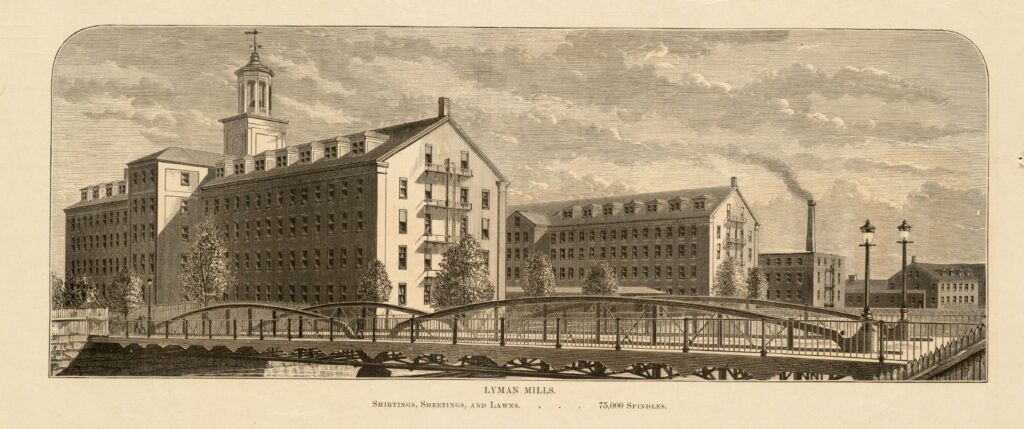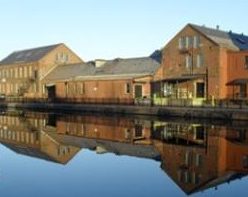[Drive from Canal Street to the start of Race Street by bearing right. Park anywhere on the side of the road within 200 feet of the start of Race Street.]
This is part of the Holyoke Heritage Trail so after visiting here get back onto the trail.
This is a very old mill that produced much low grade cotton. Its original name was the Hadley Falls Cotton Mill. From the northern end of Race Street, you can see the Lyman Mills numbers 4 and 5 (bricked together as one) and their 12 tailraces (or exit points for the canal water). From the first level canal looking east, you can see the two penstocks in front of the mill. From this vantage point, you are looking at Lyman Mill numbers 1, 2, and 3. The first stone was laid on Sept 5 1848. The first wheel spun on March 30 1850. The first manufacturing was done on April 23 1850.

Looking west from this vantage point and across the first level canal is the administration offices for the Lyman Mills. In 1927 the Lyman Mills moved to South Carolina.
At that point the Whiting Mills bought the Lyman Mills building and structures. Open Square now houses small businesses and still privately operates two turbines under the mill. Housing for the Lyman Mills workers was at same location as the present day Lyman Terrance.
Notice the many metal pipes protruding from the Lyman Mill into the Second Level Canal. These are relics of the sewage system that once flowed into the canal from the mills and the homes. Cholera and typhoid fever was rampant in the early industrial cities. John Snow of England in 1850 had determined the cause of the sickness. But London did not receive its first sewer system until 1870 when the brilliant engineer Joseph Bazalgette built the first modern sewers. Holyoke in turn used its canals as sewers from its inception in 1850 until it built a sewer system of its own in the mid-1870s. Manholes and catch basins were and are in the alleyways. The sewer system of Holyoke is still being improved. Some lines still empty directly into the river during heavy rainstorms.
The Lyman Mills were typical of mills in Holyoke. They would not only make the cotton thread on their own but would also make finished cotton products. This required 1500 looms to operate in the Lyman Mills. They would have multiple gear systems to distribute the power to the many looms.

From the northeasternmost point of the Lyman Mill, look across both Race and Main Streets. The Holyoke Water Power Administration Building was made in 1871. It is in the Second Empire Style. It is now owned by the Holyoke Gas and Electric.
To the south of Lyman Mills along the Second Level Canal was the Whiting Paper Mill number 2 and to the north was the Macintosh Mill. To the south of Lyman Mills along the First Level Canal was the Prentiss Wire Mill.

To the north is now the Wherehouse?. This Prentiss Mill made piano wire among other products. Across Race Street from the back of Lyman Mill and a little to the south is Gateway City Arts – a restaurant and art studio. This was the former home of the Judd Paper Company. Also along the north of the former Judd Paper is now Dunphy Art Studio which was once Sears Grocers. A little down the beginning of Dwight Street is Parsons Hall with its red door. Lastly, directly across Race Street is the Hotel Hamilton.
Sanborn map analysis:
Sanborn 1889 map (the 1884 map was not done for this area)
Lyman Mill Housing
Sanborn 1884 map
